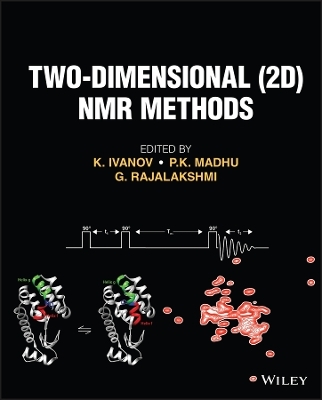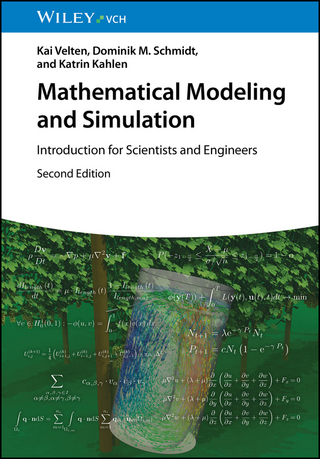
Two-Dimensional (2D) NMR Methods
John Wiley & Sons Inc (Verlag)
978-1-119-80669-1 (ISBN)
Two-Dimensional (2D) NMR Methods is a focused work presenting an overview of 2D-NMR concepts and techniques, including basic principles, practical applications, and how NMR pulse sequences work.
Contributed to by global experts with extensive experience in the field, Two-Dimensional (2D) NMR Methods provides in-depth coverage of sample topics such as:
Basics of 2D-NMR, data processing methods (Fourier and beyond), product operator formalism, basics of spin relaxation, and coherence transfer pathways
Multidimensional methods (single- and multiple-quantum spectroscopy), NOESY (principles and applications), and DOSY methods
Multiple acquisition strategies, anisotropic NMR in molecular analysis, ultrafast 2D methods, and multidimensional methods in bio-NMR
TROSY (principles and applications), field-cycling and 2D NMR, multidimensional methods and paramagnetic NMR, and relaxation dispersion experiments
This text is a highly useful resource for NMR specialists and advanced students studying NMR, along with users in research, academic and commercial laboratories that study or conduct experiments in NMR.
K.L. Ivanov (International Tomography Center, Novosibirsk, Russia) was actively involved in teaching at the Novosibirsk State University, ITC Novosibirsk, and at various schools for young researchers, and was a specialist in NMR theory and NMR methods development, notably, spin hyperpolarization methods. P.K. Madhu (Tata Institute of Fundamental Research, Hyderabad, India) has contributed to NMR relaxation theory, methods development in solid-state NMR and biophysical applications of NMR. He currently has interests in zero-field NMR and application of NMR in perovskites and battery materials. G. Rajalakshmi (Tata Institute of Fundamental Research, Hyderabad, India) is an experimental physicist developing zero to ultra-low field NMR techniques for solid-state experiments. She also works on nonlinear optical-atomic magnetometry methods for detecting dc to rf magnetic fields.
Dedication v
List of Contributors xvii
Preface xix
1 Basics of Two-dimensional NMR 1
Malcolm H. Levitt
1.1 Introduction 1
1.2 Spin Dynamics 2
1.3 One-dimensional Fourier NMR 6
1.4 Two-dimensional NMR 11
1.5 Summary 14
2 Data Processing Methods: Fourier and Beyond 19
Vladislav Orekhov, Pawel Kasprzak, and Krzysztof Kazimierczuk
2.1 Introduction 19
2.2 Time-domain NMR Signal 19
2.3 NMR Spectrum 20
2.4 The Most Important Features of FT 20
2.5 Distortion: Phase 23
2.6 Kramers-Kronig Relations and Hilbert Transform 23
2.7 Distortion: Truncation 25
2.8 Distortion: Noise and Multiple Scans 27
2.9 Distortion: Sampling and DFT 27
2.10 Quadrature Detection 30
2.11 Processing:Weighting 31
2.12 Processing: Zero Filling 33
2.13 Fourier Transform in Multiple Dimensions 33
2.14 Quadrature Detection in Multiple Dimensions 36
2.15 Projection Theorem 37
2.16 ND Sampling Aspects and Sparse Sampling 40
2.17 Reconstructing Sparsely Sampled Data Sets 41
2.18 Deconvolution 42
3 Product Operator Formalism 47
Rolf Boelens and Robert Kaptein
3.1 Introduction 47
3.2 Product Operators and Time Evolution 48
3.3 Time Evolution of the Product Operators 55
3.4 Applications 59
3.4.1 Spin-echo Experiments 59
3.5 Two-dimensional Experiments 66
4 Relaxation in NMR Spectroscopy 93
Matthias Ernst
4.1 Introduction 93
4.2 Theory 95
4.3 Relaxation in Spin-1/2 Systems: Dipolar and CSA Relaxation 104
4.4 Other Relaxation Mechanisms 125
4.5 Concluding Remarks 130
5 Coherence Transfer Pathways 135
David E. Korenchan and Alexej Jerschow
5.1 Coherence Transfer Pathways: What and Why? 135
5.2 Principles of Coherence Selection 137
5.3 Coherence Transfer Pathway Selection by Phase Cycling 140
5.4 Cogwheel Phase Cycling 146
5.5 Coherence Transfer Pathway Selection by Pulsed-field Gradients 147
5.6 Comparison Between Phase Cycling and Pulsed-field Gradients 150
5.7 CTP Selection in Heteronuclear Spin Systems 150
5.8 Additional Approaches to Coherence Selection 151
6 Nuclear Overhauser Effect Spectroscopy 153
P.K. Madhu
6.1 Introduction 153
6.2 Nuclear Overhauser Effect 153
6.3 Measurement of NOE 161
6.4 Heteronuclear NOE 161
6.5 NOE Kinetics 162
6.6 Nuclear Overhauser Effect Spectroscopy, NOESY 164
6.7 Rotating-frame NOE, ROE 166
6.8 Relative Signs of Cross Peaks 168
6.9 Generalised Solomon’s Equation 169
6.10 NOESY and ROESY: Practical Considerations and Experimental Spectra 170
6.11 Conclusions 170
7 DOSY Methods for Studying Non-equilibrium Molecular and Ionic Systems 175
Muslim Dvoyashkin, Monika Schoönhoff, and Ville-Veikko Telkki
7.1 Introduction 175
7.2 Spatial Spin "Encoding" Using Magnetic Field Gradient 175
7.3 Formation of NMR Signal and Spin Echo in the Presence of Field Gradient 176
7.4 NMR of Liquids in An Electric Field: Electrophoretic NMR 178
7.5 Ultrafast Diffusion Measurements 186
7.6 Ultrafast Diffusion Exchange Spectroscopy 189
8 Multiple Acquisition Strategies 195
Nathaniel J. Traaseth
8.1 Introduction 195
8.2 Types of Multiple Acquisition Experiments 195
8.3 Utilization of Forgotten Spin Operators 196
8.4 Application of Multiple Acquisition Techniques 198
8.5 Modularity of Multiple Detection Schemes and Other Novel Approaches 201
8.6 Future of Multiple Acquisition Detection 202
9 Anisotropic One-dimensional/Two-dimensional NMR in Molecular Analysis 209
Philippe Lesot and Roberto R. Gil
9.1 Introduction 209
9.2 Advantages of Oriented Solvents 210
9.3 Description of Useful Anisotropic NMR Parameters 213
9.4 Adapted 2D NMR Tools 221
9.5 Examples of Polymeric Liquid Crystals 226
9.6 Contribution to the Analysis of Chiral and Prochiral Molecules 232
9.7 Structural Value of Anisotropic NMR Parameters 248
9.8 Conformational Analysis in Oriented Solvents 276
9.9 Anisotropic 2H 2D NMR Applied to Molecular Isotope Analysis 277
9.10 Anisotropic NMR in Molecular Analysis: What You Should Keep in Mind 281
10 Ultrafast 2D methods 297
Boris Gouilleux
10.1 Introduction 297
10.2 UF 2D NMR Principles: Entangling the Space and the Time 299
10.3 Specific Features of UF 2D NMR 305
10.4 Advanced UF Methods 307
10.5 UF 2D NMR: A Versatile Approach 311
10.6 Overview of UF 2D NMR Applications 316
10.7 Conclusion 326
11 Multi-dimensional Methods in Biological NMR 333
Tobias Schneider and Michael Kovermann
11.1 Introduction 333
11.2 Experimental Approaches 334
11.3 Case Studies 338
12 TROSY: Principles and Applications 365
Harindranath Kadavath and Roland Riek
12.1 Introduction 365
12.2 The Principles of TROSY 366
12.3 Practical Aspects of TROSY 371
12.4 Applications of TROSY 374
12.5 Transverse Relaxation-optimization in the Polarization Transfers 379
12.6 15N Direct Detected TROSY 380
12.7 [1H,13C]-TROSY Correlation Experiments 380
12.8 Applications to Nucleic Acids 382
12.9 Intermolecular Interactions and Drug Design 383
12.10 Conclusion 383
13 Two-Dimensional Methods and Zero- to Ultralow-Field (ZULF) NMR 395
K.L. Ivanov, John Blanchard, Dmitry Budker, Fabien Ferrage, Alexey Kiryutin, Tobias Sjolander, Alexandra Yurkovskaya, and Ivan Zhukov
13.1 Introduction and Motivation 395
13.2 EarlyWork 396
13.3 Two-dimensional NMR Measured at Zero Magnetic Field 397
13.4 Nuclear Magnetic Resonance at Millitesla Fields Using a Zero-Field Spectrometer 403
13.5 Field Cycling NMR and Correlation Spectroscopy 404
13.6 ZERO-Field - High-Field Comparison 409
13.7 Conclusion and Outlook 412
14 Multidimensional Methods and Paramagnetic NMR 415
Thomas Robinson, Kevin J. Sanders, Andrew J. Pell, and Guido Pintacuda
14.1 Introduction 415
14.2 NMR Methods for Paramagnetic Systems in Solution 416
14.3 NMR Methods for Paramagnetic Systems in Solids 423
15 Chemical Exchange 435
Ashok Sekhar and Pramodh Vallurupalli
15.1 Introduction 435
15.2 Bloch-McConnell Equations 436
15.3 Studying Exchange Between Visible States 443
15.4 Studying Exchange Between a Visible State and Invisible State(s) 448
15.5 Summary 458
Acknowledgments 459
References 459
Appendix A Proton-Detected Heteronuclear and Multidimensional NMR 461
Christian Griesinger, Harald Schwalbe, Jürgen Schleucher, and Michael Sattler
Index 553
| Erscheinungsdatum | 10.07.2023 |
|---|---|
| Verlagsort | New York |
| Sprache | englisch |
| Maße | 203 x 254 mm |
| Gewicht | 1531 g |
| Themenwelt | Naturwissenschaften ► Chemie |
| Technik ► Maschinenbau | |
| ISBN-10 | 1-119-80669-0 / 1119806690 |
| ISBN-13 | 978-1-119-80669-1 / 9781119806691 |
| Zustand | Neuware |
| Informationen gemäß Produktsicherheitsverordnung (GPSR) | |
| Haben Sie eine Frage zum Produkt? |
aus dem Bereich


